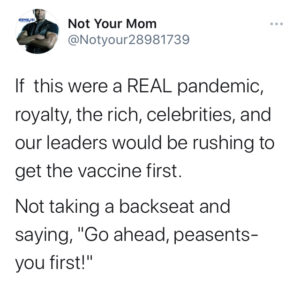
We just looked at the CDC’s total list of deaths per year (I’m not splitting hair over the 2020 numbers — I simply don’t trust any of the rona cases, nor tests) — let’s look at the rate of possibility to “infect” someone with a virus.
An analysis of risk by Bob Moran…
“First of all, given that you have no symptoms, what are the chances that you are infected with SARS-CoV-2? The UK Office of National Statistics estimates this to be 1 in 115, or 0.87%. https://www.ons.gov.uk/…/coronaviruscovid19infec…/latest
Now, imagining you are infected, but you don’t have any symptoms, what is the probability that you will infect somebody else with SARS-CoV-2? Recent studies show this is around 0.7%. https://jamanetwork.com/…/jamanetwo…/fullarticle/2774102
b) passing that infection on without symptoms. This gives a figure of 0.006%. To put that figure in context, it’s roughly the same as your chance of dying in a car crash over the course of any given year. http://www.bandolier.org.uk/booth/Risk/trasnsportpop.htmlBut if you infect someone, this doesn’t mean that they are going to end up dying of Covid pneumonia. Far from it, in fact. There is a lot of debate regarding the IFR of SARS-CoV-2, but the Centre for Evidence-Based Medicine puts it at roughly 0.5%. (99.5% of infected people survive, even higher if you’re younger) https://www.cebm.net/…/estimating-the-infection…/
Now, if we multiply the chance of infecting another person (without symptoms) by the fatality rate, we can estimate that the risk of “killing” one of your relatives is roughly 0.00003%, or 1 in 3 million.
Obviously there are a lot of caveats. If one of your relatives is very old and very ill, then the IFR is going to be higher. If they are relatively healthy, it’s going to be lower.
But there’s another caveat. PCR tests. The first number we used (the number of infected individuals in the UK) is based on positive PCR results. It is possible that only 3% of these positive results are accurate. https://academic.oup.com/…/10.1093/cid/ciaa1491/5912603
Which means that the risk of a person “killing” a relative without any discernible coronavirus symptoms may well be as low as 1 in 30 million – the same sort of likelihood of you winning the National Lottery.
Clearly, it is for individuals to assess risks for themselves and make decisions accordingly. But they should do so in the knowledge of how big those risks actually are. And nobody should be calling others “irresponsible” for taking a risk this minuscule.
Finally, this risk isn’t just the justification for ‘cancelling Christmas’, it’s the justification for all of it. Lockdowns, masks, school closures, undiagnosed cancers, suicides, stillbirths, unemployment. All done because we were told this specific risk was just too high.”
– Bob Moran of Bob’s Cartoons

But… “Bob Moran is not a doctor or scientist.”
Nope. But, HERE’S ONE! Sucharit Bhakdi is a Thai-German specialist in microbiology, having studied at the universities of Bonn, Giesen, Mainz, and Copenhagen. He also studied at the Max Planck Institute Of Immunobiology And Epigenetics in Freiburg, and is a professor emeritus of Johannes Gutenberg University Mainz, and from 1991 to 2012 was head of the Institute Of Medical Microbiology & Hygiene.
Here’s the takeaway:
don’t blindly trust the media
masks and social distancing are pointless
COVID-19 is about as serious as influenza (which isn’t very serious)
a COVID-19 vaccine isn’t necessary
go back to living a normal life.
**disclaimer: ANY numbers reflecting infection/contagion via a virus makes the high assumption that viruses work the way we are being told. In the words of Dr. Mikovits, “dig deeper.”
p.s. Asymptomatic = presenting no symptoms or evidence of illness or abnormality = HEALTHY!